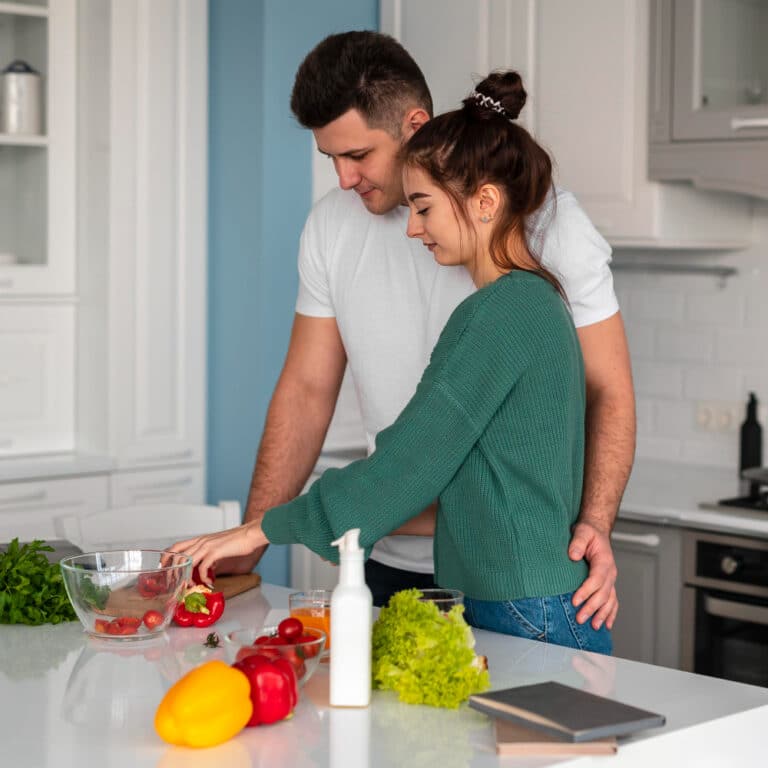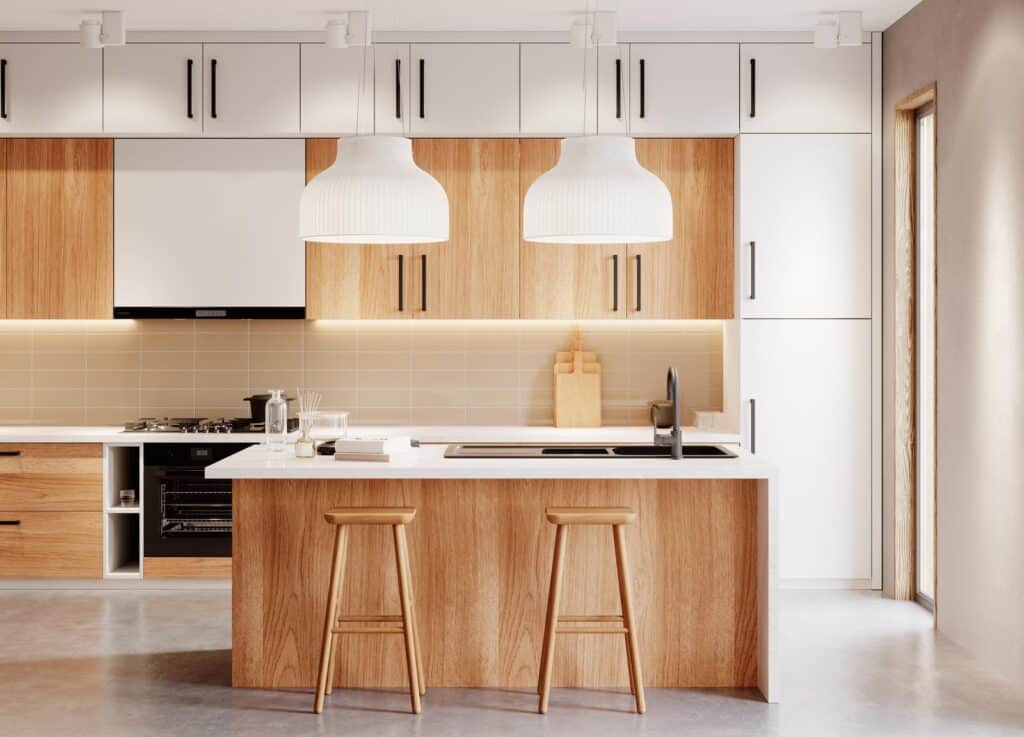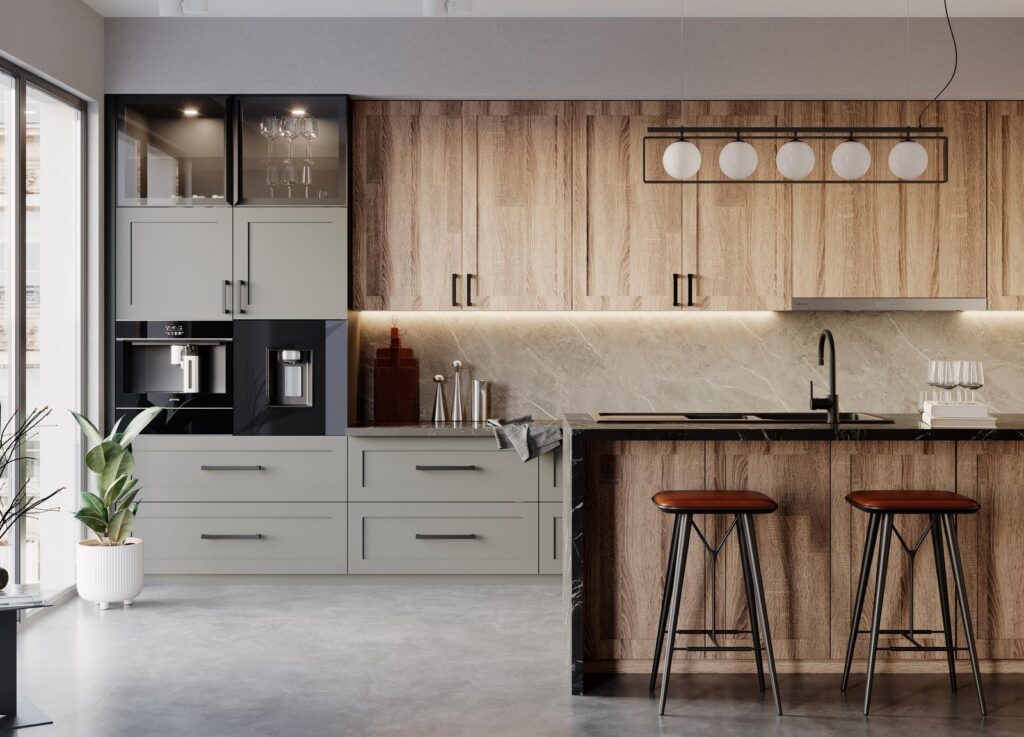All our kitchens
Filters
Our traditional covers, Shaker, Circe, Rattan, and Achilles which we touched up with modern technology, are just for those who can not give up on traditional styles.
-Our modern kitchens emerged with the reflection of modern inner beauty. Fluted, Slab and Aluminum styles.
-Make your choice with stunning glossy kitchens, matte options, wood patterns, and natural wood veneers

Free kitchen design service
Visit our authorized stores and see our samples to get information by meeting face to face with our authorized sales representative.
Make an appointment for a virtual meeting and design together with our designers online.
After the process you will be able to get 3D visuals, detailed drawings and a quote.
Save, view and confirm your design and quote online in your CRM account.
The kitchen is where you spend time with family and loved ones, where your memories make their way to your dining table, or where you relieve stress by enjoying the warmth after a long day.
Your kitchen is the heart of your home, and you are the one keeping it beating. The saying goes that the beauty of nature reflects on everything. Therefore we are delighted to present you with various materials, models, and colors to make the heart of your home even more beautiful.
Start planning your kitchen

Planning your dream kitchen

How to buy a Bienal cabinet

Installing your kitchen

Flexible finance options
Anyone can make cabinets, but charming kitchens that will change the atmosphere of your home and fulfill your desires can be created in Bienal. Pick from our wide range of kitchen styles from our menu to the left, and then choose from our selection of versatile colors.
Frequently Asked Questions
Is it cheaper to buy your own kitchen cabinets?
The answer to this question really depends on a few key factors. The type of cabinets you plan to buy, the quality of the product, the installation costs and where you shop are all important pieces to consider when determining overall cost.
When considering materials, wood is generally more expensive than laminate or MDF (Medium-Density Fiberboard) but can also have a higher return on investment as it is often considered more durable than other materials and can be stained or painted multiple times over its lifespan. Additionally, stock cabinets may cost less upfront but they tend not to provide quite the same level of customization as custom cabinetry does.
The installation process can also add significantly to your total expenses; depending on the complexity of your kitchen layout and whether there are any upgrades needed for plumbing or electrical wiring, labor charges could easily double what you spend up front. Many places offer both in-store and online design services which help tremendously in terms of creating an accurate budget before making a purchase decision.
Additionally, shopping around for competitive prices will help ensure that you’re getting the best bang for your buck from all angles—materials, installation costs and warranties carriered with certain brands should all be factored into your decision making process so don’t forget to look at those things too!
What is the average cost of a set of kitchen cabinets?
According to the National Kitchen and Bath Association (NKBA), the average cost of a set of kitchen cabinets is approximately $10,000. This figure varies greatly depending on factors such as size, materials used, brand name, installation fees, delivery costs and other associated expenses.
The most important factor that affects the cost of kitchen cabinets is material selection. Different woods have different ranges in terms of durability and prices. Plywood or particleboard are considered entry-level materials while custom solid wood or exotic veneers are more expensive options.
Kitchen cabinetry also comes in various configurations ranging from standard stock models to semi-custom models with limited options for sizing, styling and finish details that can be adjusted accordingly according to personal preferences. As a result, prices for semi-custom units typically range from $4,000 – $20,000 for an average sized kitchen depending on sizes chosen in relation to door style selected and other add-on amenities included like pull out shelving drawers etc…
In addition to material selection it should also be taken into account that cabinet installations often require additional services such as demolition work as well as electrical wiring system upgrades if necessary which can contribute significantly towards overall costs when factoring in labor charges by skilled contractors who specialize in this field. In general most deliveries will come with a set up crew too who can manage all aspects related to these type installations by either themselves or working through local carpenters/contractors located nearby your residence if needed or requested.
Overall one must keep close watch over any changes that may affect the bottom line when comparing quotes given before making purchase decisions so they are aware of what they’re investing into when it comes time to pay up at completion stage after project has been thoroughly inspected by them first prior signing off on any items(s).
What is the cheapest way to do kitchen cabinets?
One of the most cost-effective ways to update your kitchen cabinets is to simply give them a new coat of paint. Painting your existing cabinets is an affordable and straightforward way to completely change their look without having to invest in all-new cabinetry. If you’re on a tight budget, this can be an economical alternative that requires minimal prep work and can be completed relatively quickly.
Before starting the project, it’s important to do some research into what type of paint will best suit your needs; most cabinet paints are either oil- or water-based. Generally speaking, water-based paints offer better coverage than oil base, but they also require more drying time between coats so it’s important to read up on which option would work best for you.
Once you select the correct paint for the job, get started by thoroughly cleaning each of your cabinet doors with a damp cloth – make sure not to leave any fingerprints or residue behind as this could interfere with adhesion once painted – then lightly sand each door before painting by using 400 grit sandpaper and wipe away any dust afterward using a tack cloth.
Next, apply primer and let it dry completely before adding one (or two) thin layers of topcoat – note that if you plan on adding additional layers of topcoat its best practice not use too much pressure when brushing on; otherwise marks from bristles may appear in the finish – then allow 24 hours for drying before rehanging them back in place once done!
Finally, if desired provide further protection against dirt buildups and discolorations due by applying a layer of sealer or varnish after everything else has fully dried – typically only one light coat should do depending upon brand selected plus extra wear protection will vary based upon selected finish as well . With this method finished product should last several years come rain or shine!
Can I build my own kitchen cabinets?
Yes, you can build your own kitchen cabinets! This is a great way to add a unique and personal touch to your home. Building your own kitchen cabinets requires basic carpentry skills and knowledge of the tools needed to accomplish this task.
First, if you don’t already have woodworking experience, it would be best for you take some courses or read up on the basics of woodworking. You want to make sure that you are familiar with all aspects of the project before beginning. Next, decide what design and overall look that you would like your kitchen cabinets to have. Once that is decided, measure out the space where they will go in order ensure accurate sizing when building them.
When picking out materials for constructing the cabinet boxes, it is important that they are sturdy enough since they need to support countertops and appliances safely without any problems arising later on down the road. Typically, plywood such as birch or maple works best for this application because it can endure heavy weights easily while also providing an attractive look at a reasonable price point. As far as hardware choices go; standard butt hinges work well but there are other options such as invisible spring-loaded models if desired which provide superior functionality with minimal visibility from outside view points (homesfeed).
After procuring everything needed for constructing your custom cabinetry: planks of wood cut into proper dimensions (lengths/widths), supports under shelves (to prevent sagging), panels for attaching door handles/hinges—it’s time to assemble! Begin by assembling each individual box without including drawers/doors yet since those require specific measurements based upon their sizes alone; then attach them together by using screws drilled into pre-drilled holes marked off beforehand in order ensure accuracy via predefined measurements taken during initial planning stages of this project (Family Handyman). Once everything has been put together carefully without any gaps between joints or pieces; proceed by attaching doors onto each cabinet section using screws again while making sure they open/close smoothly so there won’t be any issues afterwards when installing drawers within these compartments powered with glides enabling full access from either end—these being inserted prior installation completion due them being difficult otherwise once everything else has been put in place solidifying its structure preventing easy access afterwards if done afterwards instead due too much struggle involved having no loose parts allowing leeway easing process considerably! Finally finish off entire setup accordingly before affixing various handles following per user preferences either giving modernistic flair ultra-modern vibe alike utilizing high lustrous metal knobs resembling future designs found only movies showcasing latest trends world today OR sticking original classic style metal handles making one nostalgic recalling past times glory days gone yore residing deep within hearts forevermore thereby concluding journey thus far embarking new endeavor soon come… –
What is a good budget for a kitchen?
When it comes to determining a budget for your kitchen, there are a few key factors to consider. First and foremost, it is important to determine the size of the kitchen. For instance, if you have a smaller kitchen space you may be able to get away with spending less money as compared to if you had more square footage in which case you should plan for higher costs.
The second factor that plays heavily into budgeting for your kitchen is the features and amenities included in the renovation. Do you need new appliances such as stoves and fridges? Will cabinets be replaced or re-faced? Are there extra electrical outlets that need to be installed or upgraded? All of these extras can add up quickly so understanding what needs work before setting out on your planning journey is key.
In addition, when setting a budget it’s important not only consider what styled finishes will cost but also how much labor will cost depending on how involved each job may be (such as replacing outdated wiring). Once all of those components are factored in further decisions can then go towards styling pieces such as countertops, backsplash tile, hardware and paint colors while fitting within your desired range. A good rule of thumb might be 10%-15% going towards design elements like wallpaper/paint/countertops etc., 20%-30% going towards cabinetry & hardware; 35%-50% going toward appliances; remaining funds focusing on labor & permitting costs.Soliarily though this number tends vary greatly from person to person depending upon individual tastes and style preferences so try thinking through all of the detaiils before executing any big changes!
What is the most expensive type of kitchen cabinets?
The most expensive type of kitchen cabinets are custom-made, handcrafted models. They allow for a wide range of customization options and can be made from the highest quality materials available. Generally speaking, these cabinets will cost several thousand dollars or even more depending on the size, material selection, labor involved in their construction and any other customizations that you may request.
The costliest of all kitchen cabinet types would likely be those constructed using exotic hardwoods such as ebony or rosewood. These types of woods are inherently dense and heavy, while also being extremely beautiful when they have been finished with a lustrous coat of lacquer. Additionally, some finely hand-carved cabinetry might feature intricate designs which add to their hefty price tag. Other luxurious choices include semi-custom European style integrated cabinetry that is usually fitted with top-of-the-line accessories such as pullout drawers for easy access to frequently used items as well as millwork finishes like crown moulding and wainscotting throughout your kitchen space.
No matter what type of kitchen cabinets you choose for your home renovation project, it is important to remember that quality materials combined with proper craftsmanship will always result in timeless features that can last generations if properly cared for. Keep this in mind when deciding how much you are willing to spend on this important investment in order to ensure lasting value no matter where life takes you!











